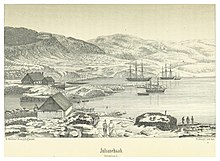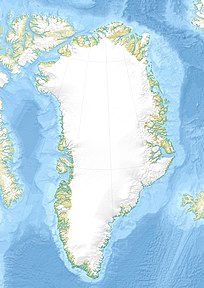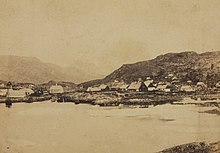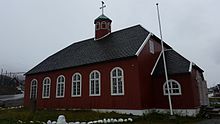Qaqortoq
| Qaqortoq (the white) | ||
|---|---|---|
|
Julianehåb (Julian's Hope) K'aĸortoĸ |
||
| Qaqortoq (2013) | ||
| Commune | Kujalleq municipality | |
| District | Qaqortoq | |
| Geographical location | 60 ° 42 '59 " N , 46 ° 1' 59" W | |
|
|
||
| Residents | 3,050 (January 1, 2020) |
|
| founding | 1776 | |
| Time zone | UTC-3 | |
Qaqortoq [ qɑˈqɔtːɔq ] (according to the old spelling K'aĸortoĸ ; Danish Julianehåb [ juliˈaːnəˌhɔˀb ]) is a Greenland city in the district of Qaqortoq in the municipality of Kujalleq . As the fifth largest city in the country, Qaqortoq is both the capital of the former Qaqortoq municipality and the current municipality.
location
Qaqortoq lies at the tip of a jagged, narrow peninsula in southern Greenland that rises near Igaliku . In front of the city, the Qaqortup Ikera separates Qaqortoq from the island of Akia , a strait into which the Igalikup Kangerlua flows. East of Qaqortoq, the peninsula is cut by two straits around the island of Arpatsivik , which merge into the bay-like fjord Qaqortukuluup Imaa . Qaqortoq is surrounded to the west and east by mountains, between which lies the great lake Tasersuaq to the northwest . The closest place is Eqalugaarsuit, 13 km southeast .
history
18th and 19th centuries

The Danish merchant Peder Olsen Walløe built a peat wall house in Qaqortoq in 1751, where he spent the winter. He recognized the place as a good harbor and a good hunting ground. The house was still standing at least in 1914 when Louis Bobé put an inscription in memory of Walløe.
In the summer of 1775, Anders Olsen founded the Julianeshaab colony in Qaqortoq. He named her after the Danish Queen Juliane Marie , who was the widow of King Friedrich V at the time. The name later became Julianehaab . Anders Olsen stayed in the colony only until 1780 before he settled in old age as a rancher in Igaliku , where he left an important family.
In 1802 Niels Rosing Bull described the colony as a very advantageous place.
20th century
From 1911 Qaqortoq was the main town of the Julianehaab community, to which the Kangermiutsiaat residential area still belonged, but which was actually outside the community boundary . The municipality was part of the 4th district electoral district of South Greenland.
In 1919 there were 21 Europeans and 390 Greenlanders in Qaqortoq. Among the European residents were the colonial administrator, the assistant, a volunteer, a boatman, a sheep farm experimenter, a doctor, a nurse, and the pastor. Among the Greenlanders were 46 hunters, nine fishermen, a chief, two boatmen, three carpenters, a blacksmith and gunsmith, a machinist, five cooper, two colonists, six apprentices, a midwife, a shepherd helper, two catechists and a reader. The Greenlanders lived in 58 houses. The colonial administrator's apartment dates from 1804 and was a 184 m² building with five rooms, an office and shop and storage room on the top floor. The assistant's apartment was built in 1890, was a half-timbered building with planking, measured 119 m² and had three rooms and a kitchen. The skipper's apartment dates from 1849 and was a stone house of 71 m² with two rooms and a kitchen. The team house was also built in 1849 and was identical in construction. There were also two provision shops from 1853 and 1914, a carpenter and cooper's workshop from 1781, a blacksmith's shop from 1871, a bakery from 1863, a bacon house with provisions store from the 18th century, a distillery from 1878, a brewery, a boathouse Material house, two coal houses, a barrel house, a powder house and a stable. The medical system had an old stone hospital, a pharmacy as a peat wall house, a new hospital from 1908 with 133 m² with three sickrooms for 15 patients, an operating theater and a room for the nurse, as well as a doctor's apartment from 1886, which was 116 m². The church measured 154 m² and was built in 1832. It was originally built in the Norwegian style, but was completely rebuilt in 1911. The pastor's apartment measured 89 m² and was a storey building from 1872 with four rooms, a veranda, a kitchen, two attic rooms, a stable and an outbuilding. The school was built in 1909, was 135 m² and had two rooms, a meeting room and a mortuary chapel.
Initially, the place was completely between the two flanking mountains on the river that connects the Tasersuaq with the sea. By the 1930s, however, the place had grown so much that the two mountains were also built. Qaqortoq was the capital of the municipality of Qaqortoq from 1950 until the administrative reform in 2009 and has been the capital of the municipality of Kujalleq ever since .
List of colonial employees until 1921
Colonial administrator
The following people worked as colonial administrators of the Julianehaab colony until 1921.
- 1773-1780: Anders Olsen
- 1780–1787: Niels Møller Thomsen
- 1787: Niels Christian Mathiesen
- 1787–1794: Jørgen Christoph von Koppelow Lund
- 1794–1806: Johan Christian Mørch
- 1806–1807: Eylert Schythe (interim)
- 1807–1813: Johan Christian Mørch
- 1813–1820: Wilhelm Mathias Olrik
- 1820-1821: Rasmus Jensen
- 1821–1826: Jørgen Monrad
- 1826–1827: Jens Mathias Mathiesen
- 1827–1830: Gerhard Heiberg Wolff
- 1830–1832: Jens Mathias Mathiesen (interim)
- 1832–1834: Gerhard Heiberg Wolff
- 1834–1841: Frederik Lassen
- 1841–1842: Ove Valentin Kielsen (interim)
- 1842–1846: Johannes Haberdorff Lytzen (interim)
- 1846–1847: Ove Valentin Kielsen (interim)
- 1847–1850: Frederik Lassen
- 1850–1852: Holger Biilmann
- 1852–1853: Ove Valentin Kielsen
- 1853–1856: Bendix Andreas Heide Tvede
- 1856–1861: Jørgen Nielsen Møller
- 1861–1863: Albert Emil Blichfeldt Høyer
- 1863–1867: Lars Frederik Larsen
- 1867–1872: J. Georg Kursch
- 1872: Einar Hansen
- 1872–1873: Ulrik Frederik Rosing (interim)
- 1873–1880: Hans Frederik A. Hansen
- 1880: Carl Julius Peter Ryberg (interim)
- 1880–1884: Carl Emil Olfert Lytzen
- 1884–1885: Conrad Poul Emil Brummerstedt (interim)
- 1885: Johan Christian Simony (interim)
- 1885–1892: Carl Emil Olfert Lytzen
- 1892–1895: Conrad Poul Emil Brummerstedt
- 1895–1896: Carl Ringsted (interim)
- 1896–1902: Conrad Poul Emil Brummerstedt
- 1902–1907: Herjulf Carl Georg Jørgensen
- 1907–1909: Oscar Peter Cornelius Kock
- 1909–1910: Christian Sigvald Jensen Langskov
- 1910–1911: John Christian Gustav Baumann
- 1911–1913: Christian Sigvald Jensen Langskov
- 1913–1914: Poul Hermann Ibsen (interim)
- 1914–1916: Christian Sigvald Jensen Langskov
- from 1916: Oluf Hastrup
Missionaries and pastors
The following missionaries and pastors were employed in the colony until 1921. From 1811 to 1812, 1842 to 1843 and 1877 to 1879 missionary of the Frederikshaab colony was responsible. From 1815 to 1817 the colony belonged to the parish of the Godthaab colony . From 1812 to 1815 and from 1824 to 1825 there was no missionary.
- 1779–1788: Hans Buch
- 1788–1794: Niels Giævertsen Titchen
- 1794–1800: Lauritz Gudde
- 1800-1806: Rasmus Knudsen
- 1806–1811: Christian Frederik Fleischer
- 1817–1824: Poul Gotfred Wanning
- 1826–1835: Magnus Wilhelm Esmann
- 1835–1841: Jørgen Frederik Jørgensen
- 1841–1842: Hans Peter Bech
- 1843–1851: Hans Frederik Ivar Henrik Vesterboe
- 1851-1853: Carl Emil Janssen
- 1853–1861: Ulrik Peter Christian Nissen
- 1861–1868: Christian Heilmann Rosen
- 1868–1874: Moritz Christian Julius Anthon
- 1874–1877: Lauritz Theodor Ostenfeldt
- 1879–1887: Otto Christopher Skaarup
- 1887–1892: Edvard Ægidius Lützen
- 1892–1900: Poul Moth Thestrup Engberg Frantzen
- 1900-1904: Poul Hansen Vibæk
- 1904–1908: Nikolaj Frederik Severin Balle
- 1908–1910: Carl Ferdinand Wagner
- from 1910: Erik Jespersen
doctors
The medical district was headed by the following doctors until 1921.
- 1838–1850: Johannes Haberdorff Lytzen
- 1851–1855: Andreas Steener Iversen Haalland
- 1855–1862: Ludvig Henrik Prosch
- 1863: Johan Heinrich Gundelach
- 1863–1864: Anthon Peter Christian Tegner (interim)
- 1864–1871: Johan Heinrich Gundelach
- 1872–1877: Otto Jessen
- 1877–1882: Hugo Otto Johannes Schmedes
- 1882-1892: Carl Ludvig Theodor Ibsen Lindemann
- 1892–1897: Fritz Emil Thorvald Jørgensen
- 1897–1903: Gustav Axel Nielsen Meldorf
- 1903–1906: Henrik Deichmann
- 1906–1910: Regnar Vilhelm Gerhard Bentzen
- 1910–1911: Carl Martin Norman-Hansen (interim)
- 1911–1916: Regnar Vilhelm Gerhard Bentzen
- 1916–1917: Holger Lützhøft Christensen (interim)
- 1917–1921: Regnar Vilhelm Gerhard Bentzen
economy
Qaqortoq has a distinct economic structure. The town has a tannery and a sewing shop for the Great Greenland company , which processes seal skins , as well as many other small craft businesses. Traditionally, fishing and seal hunting also play a role in Qaqortoq, as does tourism. Qaqortoq is one of the most beautiful places in the country and the nearby medieval church ruins of Hvalsey in Qaqortukulooq also attracts tourists.
Infrastructure and supply
The port of Qaqortoq is located in the narrow Umiarsualivik bay , which is why no large ships can land there, only the smaller ferries of the Arctic Umiaq Line . There are therefore options for the creation of a seaport are examined. Qaqortoq has a well-developed road network. Domestic traffic is carried out by boats, ships and via the Qaqortoq heliport . The construction of the airport in Qaqortoq was decided in 2018. The regional airport will be built six kilometers north of the city.
Qaqortoq has had a fully developed sewer network since 2009. The city's garbage is dumped or incinerated in the landfill west of the city. Nukissiorfiit supplies Qaqortoq with electricity from the waterfall power plant in Qorlortorsuaq . Most of the heat is supplied from the residual heat from waste incineration or electricity production and from oil stoves. Drinking water is obtained from the Tasersuaq by a waterworks built in 1961 and renovated in 2010. TELE Greenland is responsible for telecommunications in Qaqortoq. The submarine cable Greenland Connect ends in Qaqortoq, which enables fast internet in Greenland.
Development
Qaqortoq is an important educational center in Greenland. The elementary school Tasersuup Atuarfia taught more than 400 students and was extensively modernized in the early 2010s. It also has a special school for mentally or physically handicapped children. The city also has a branch of the Middle Greenland High School (GUX), which covers the entire municipality. There is also a branch of the Greenlandic vocational schools (Piareersarfik) and a branch of the Niuernermik Ilinniarfik business school in Nuuk, as well as one of the two Greenland universities, Sulisartut Højskoliat . There are four day-care centers in the city and the Ajasivarsik retirement home, which opened in 1996 .
In Qaqortoq there are two branches of Brugseni , two of Pisiffik , three of Spar , and one Torrak and one JYSK branch each , which supply the residents with goods. There is also a hotel, a restaurant, the Qaqortoq Museum , a post office and the local government in the city. The old Annaassisup Oqaluffia (Frelserens Kirke) from 1832 has the inside lifebuoy of Hans Hedtoft hang above a plaque that commemorates the victims of the sinking of the ship in 1959, in which, among other politicians augo Lynge and Carl Egede died. The younger church, named after Gertrud Rask , dates back to 1973. Qaqortoq is one of three Greenland cities with two churches. In the city center a 1932 is Pavia Høegh landscaped fountain , the only in the country. Around it are the oldest and listed buildings in the city, the oldest of which dates from 1797. Pavia Høegh's granddaughter Aka Høegh initiated the art project “Sten og Menneske” ( German stone and man ) in the mid-1990s , in which 18 Scandinavian artists created sculptures and wall reliefs carved in granite.
sons and daughters of the town
- Christian Søren Marcus Olrik (1815–1870), Danish-Greenlandic teacher, zoologist, botanist, merchant and inspector of Greenland
- Johannes Hansen (1837–1911), catechist and expedition member
- Frederik Tryde Lassen (1838–1920), Danish inspector of Greenland
- Johannes Josephsen (1868–1931), Provincial Councilor
- Pavia Høegh (1886–1956), carpenter, architect and councilor
- Isak Lund (1889–1974), catechist and councilor
- John Høegh (1890–1966), blacksmith, photographer and councilor
- Kathrine Chemnitz (1894–1978), women's rights activist
- Frederik Høegh (1895–1970), printer, editor, businessman and councilor
- Erling Høegh (1924–1993), politician, pastor, teacher and radio play author
- Ingvar Høegh (1927–2007), politician (Atassut)
- Oluf Høegh (1927–2018), National Councilor
- Niels Henrik Lynge (* 1937), journalist, translator and musician
- Henrik Lund (1939–2003), politician (Siumut), consul general and journalist
- Torben Emil Lynge (* 1940), politician and teacher
- Emil Abelsen (1943–2005), politician (Siumut)
- Kaj Kleist (* 1943), teacher and civil servant
- Aqqalukasik Kanuthsen (* 1953), politician (Inuit Ataqatigiit)
- Buuti Pedersen (* 1955), artist
- Sofia Rossen (* 1961), politician (Inuit Ataqatigiit)
- Tommy Marø (* 1964), politician (Siumut)
- Inuk Silis-Høegh (* 1972), director and artist
- Angu Motzfeldt (* 1976), singer-songwriter
- Bolatta Silis-Høegh (* 1981), visual artist and children's book author
- Mille Kongstad (* 1989), badminton player
Population development
The population of Qaqortoq has remained relatively constant at around 3,100 since the mid-1980s. This makes it the largest city in South Greenland and the fifth largest city in the country.

panorama
Web links
Individual evidence
- ↑ Map with all official place names confirmed by Oqaasileriffik , provided by Asiaq
- ↑ a b c Louis bobe : Beskrivelse af Distrikterne i Sydgrønland: Julianehaab district. History. Colonies . In: Georg Carl Amdrup , Louis Bobé , Adolf Severin Jensen , Hans Peder Steensby (eds.): Grønland i tohundredeaaret for Hans Egedes landing (= Meddelelser om Grønland . Volume 60-61 ). tape 2 . C. A. Reitzel Boghandel, Copenhagen 1921, p. 554 f . ( Digitized in the Internet Archive ).
- ^ A b Ole Bendixen : Beskrivelse af Distrikterne i Sydgrønland: Julianehaab District. Bopladser i Julianehaab district. Julianehaab colonies . In: Georg Carl Amdrup , Louis Bobé , Adolf Severin Jensen , Hans Peder Steensby (eds.): Grønland i tohundredeaaret for Hans Egedes landing (= Meddelelser om Grønland . Volume 60-61 ). tape 2 . C. A. Reitzel Boghandel, Copenhagen 1921, p. 504 ff . ( Digitized in the Internet Archive ).
- ↑ a b c Qaqortoq at kujalleq2017.odeum.com
- ^ Qaqortoq in Den Store Danske
- ↑ a b c Louis bobe : Beskrivelse af Distrikterne i Sydgrønland: Julianehaab district. History. Danske Embedsmænd ved Julianehaab . In: Georg Carl Amdrup , Louis Bobé , Adolf Severin Jensen , Hans Peder Steensby (eds.): Grønland i tohundredeaaret for Hans Egedes landing (= Meddelelser om Grønland . Volume 60-61 ). tape 2 . C. A. Reitzel Boghandel, Copenhagen 1921, p. 558 f . ( Digitized in the Internet Archive ).
- ↑ a b Qaqortoq at groenlandkreuzfahrt.de
- ↑ Population of Qaqortoq 1977–2020 at bank.stat.gl







